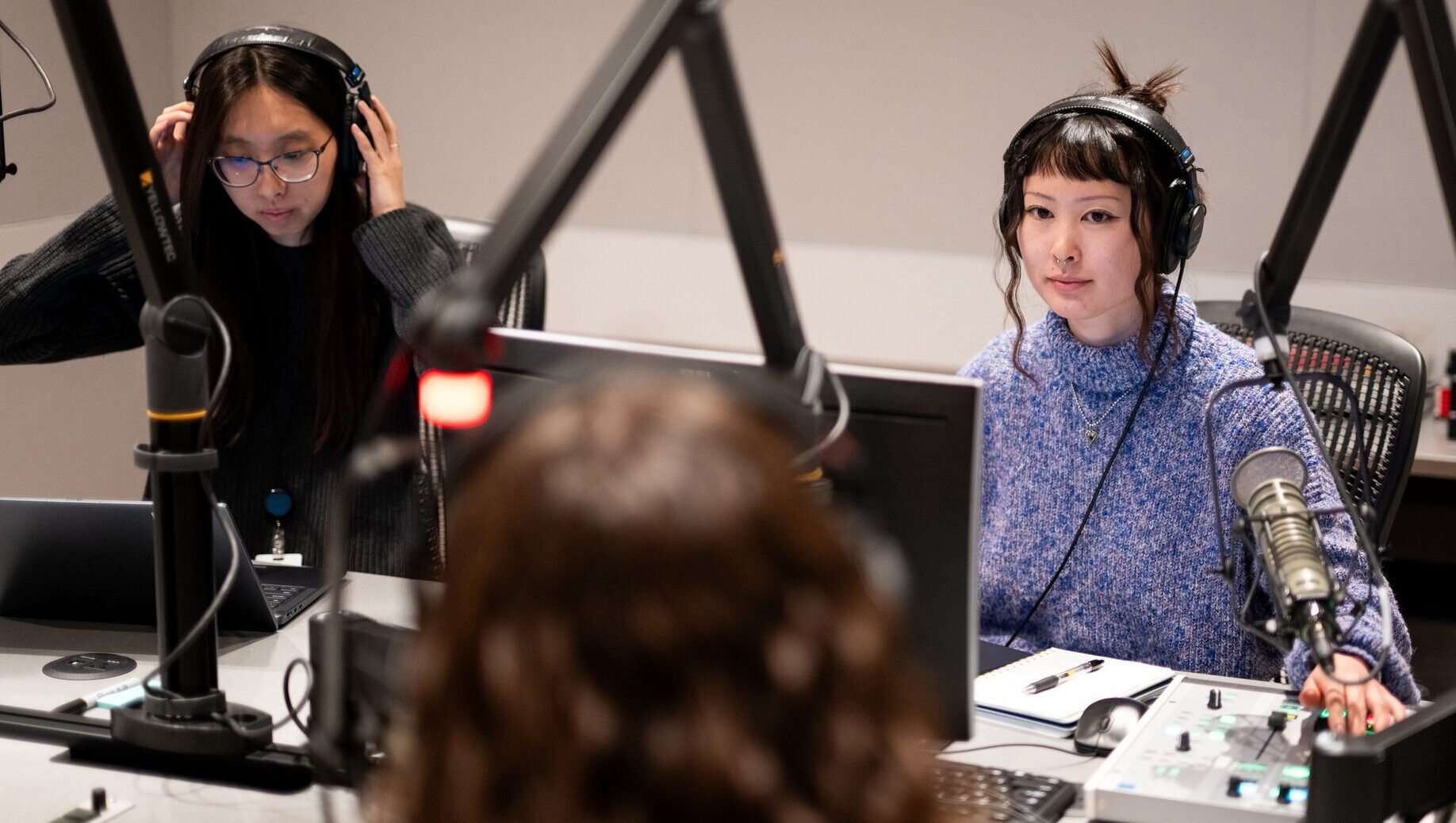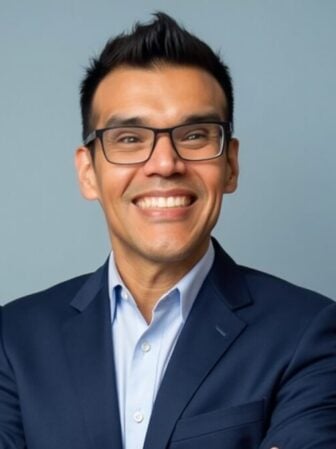How promos can build audience, and trust, for public media journalism

Beth LaBerge / KQED
KQED TVC producers Jennifer Ng, left, and Emiko Oda interview reporter Erin Baldassari on Wednesday.
At KQED in San Francisco, digital strategists and the radio programming team have landed on a provocative strategy that positions radio — the place where our audiences still show up in large, loyal numbers every day — as the beginning of a digital journey.
The destination? A place where listeners go deeper into the organization’s digital ecosystem. Right now that includes journalism published on the website. We’re also looking to expand into platforms as diverse as KQED’s app, Discord and community engagement efforts.
Like all public media, KQED aspires to build audience engagement and loyalty. To that end, our news and radio departments began exploring how to support this aspiration several years ago. Rather than viewing radio as something to move beyond, we approached it as a foundation for building stronger, more integrated connections between audiences and all of KQED’s platforms.
The intervention became the seed of something new at KQED: Trusted Voice Content. We’ve come along far enough at this effort to explain how you can do this, too.
Speaking to people
Public radio people know the script well: “Stay tuned for ….” These quick reminders to the listener during program breaks are foundational to broadcast flow. They work as informational guides, but they rarely inspire listeners. They tell the audience what is coming, not who is behind it, or why it might matter to someone personally.
What if public radio could turn that convention on its head? At the beginning of this process, we talked about how trust in journalism is built, and how much of that trust still comes from the journalist’s perspective. More specifically, we realized that what distinguishes KQED for audiences isn’t just the stories they hear on radio, but the people who tell them. Time-worn marketing practices use spokespeople. For public media, the challenge is expanding relevance and trust editorially.
We asked, “Instead of hearing an announcer rattle off the program schedule, what if listeners got insight into the actual people behind the stories — the reporters, hosts and editors whose curiosity and care make the work credible?
Our initial scan did not reveal many other newsrooms that take this approach, though public broadcasters like the BBC have long recognized that familiarity with on-air talent builds audience trust. A goal of TVC was to make that trust more intentional, and more local.
So, the thinking shifted to being intentional. What the story was — or even why it mattered — was ancillary to who was creating it and why it was interesting. A cultural reporter confessing their love of pancakes for a story about late-night diners. A science journalist talking about the moment a source surprised them. A station leader giving the loyal listener a peek behind the curtain of their daily routine.
Such moments are short, unscripted and, above all, human. They don’t replace the broadcast promotions stations depend on. Instead, these moments make the listener pause. They create warmth, intimacy and trust. They invite the listener to see a reporter not just as a byline, but as a person worth knowing, liking and trusting.
That’s the essence of Trusted Voice Content.
How we built this
The strategy started as a small experiment. KQED’s newsroom would produce short-form audio segments, up to 30 seconds. Segments would air in the same spaces where the usual broadcast promotions run. TVC, however, would offer a different sound and destination.
The goal for these spots was to drive audiences to digital. Every TVC would point a listener to content available on kqed.org.
At KQED, the Express Desk was the natural home for this work. This unit is a rapid-response digital team that functions as both an engine for daily news and a lab for experimentation — testing new formats, workflows and strategies to connect audiences more directly with KQED’s journalism.
With the framework of the strategy laid out, the next task was winning over people. Within KQED’s leadership, the experiment initially sparked concerns about cannibalizing the audience that ardently listens to FM. By encouraging online visits, the logic went, we would be urging listeners to turn off the radio.
But our intention was for TVC to function in the ways that today’s audiences use media. Many people multitask and can easily listen to KQED radio while looking at their computers or phones. In this context, TVC serves the important function of boosting digital readership while keeping radio front of mind. If a TVC presents something funny, vulnerable or surprising, it’s similar to the proverbial driveway moments. The listener or digital reader remembers hearing it on KQED. They think of us as a place where unique people share interesting stories that are locally relevant.
When we began putting these theories into practice, TVC was set up as an unscripted encounter. The person at the mic was treated as a subject matter expert. Producers got curious, asking what they remembered most, or about a moment or day. All of these recordings were timeboxed to be completed in less than 15 minutes.
Responses to early TVC segments were striking. Listeners leaned in. Reporters who participated enjoyed being able to speak in their own voices, not just as “the voice of the story.” Digital analytics showed something even more shocking: Stories with accompanying TVC saw higher traffic and engagement than stories that aired without it. But the segments also helped boost website traffic for news stories overall.
The Express Desk discovered that TVC dramatically increased traffic for the digital stories we promoted, while also driving up interest from audiences who continued to consume KQED’s online content.
In January 2025, KQED’s original digital stories averaged fewer than 6,000 page views each. The first month we began applying Trusted Voice Content, stories featured with TVC generated an average of 25,000 page views each. By April, when two stories per week received the TVC treatment, average views across all stories rose to about 7,500, suggesting that TVC has had a measurable and sustained impact on overall web traffic. In addition, stories enhanced with TVC often kept readers on KQED’s website for minutes longer than other pieces.
The newsroom wasn’t the only department paying attention. Innovative members of our development team asked if KQED could extend TVC into fundraising for California Public Radio Day. The answer was a resounding “Yes!”
Throughout the day’s promotional rotations, reporters and hosts shared prerecorded personal reflections about why public radio mattered to them and to the Bay Area community. Those pieces aired 31 times. TVC was a separate but significant contributor to the campaign’s success, complementing email and social media efforts that together generated more than $160,000 in donations in a single day.
TVC was a revelation. By showing the people behind the work, KQED reminded its audience that gifts support not just programs, but neighbors, reporters and storytellers living in the same region, caring about the same issues.
What we’ve learned so far
Your organization doesn’t have to set up an Express Desk to try this strategy. In fact, three lessons stand out from KQED’s TVC journey to date:
1. Short and human beats polished and perfect.
Many audience members seem to prefer spots that feel spontaneous and real over polished with production sheen. A reporter laughing at themselves or describing a moment that made them nervous can be more memorable than a flawless script.
2. Audience curiosity is broad.
Some of our most resonant TVCs were tied to everyday details that reveal character rather than weighty news reports. Examples include a housing reporter reflecting on the complex issues facing those in poverty and a KQED host describing what they love about interviewing. These glimpses of personality build parasocial relationships that traditional promos never could.
3. Cross-department collaboration is key.
TVC succeeded because editorial, programming and other teams all had a stake. When the Express Desk showed that a storytelling experiment could also increase donations and web traffic, leadership committed resources to grow the initiative. Starting this fiscal year, KQED is investing in a dedicated team to create more TVC consistently, with newsroom leadership at the helm.
The TVC team also learned some important lessons along the way, including:
- Overscripting kills authenticity.
- Too many voices in one piece dilutes impact.
- If you treat these opportunities like an afterthought, they sound like one.
Why now
Public radio stations face broadcast challenges, fierce competition for digital attention and funding cliffs that require them to cultivate new forms of loyalty. Amid these difficulties, TVC isn’t a magic bullet. It’s a reminder of a simple truth: Public radio’s greatest asset is not programs, but people.
Public radio still reaches millions of listeners every day. Instead of treating broadcast reach as a legacy liability, think of it as a bridge. A trusted voice on the radio can become a trusted presence online, in newsletters, on stage at events, or in a fundraising campaign.
For KQED, TVC has made radio feel lively. It has turned the in-between moments into places of genuine connection.
Looking ahead
KQED’s commitment is clear: TVC is a core strategy, not a side project. With newsroom investment and leadership backing, the Express Desk is scaling TVC to become a regular part of KQED’s broadcast and digital offerings.
The TVC team envisions a future where:
- Every major story has an accompanying TVC, produced quickly and shared widely.
- Reporters see TVC as a natural extension of the work, not an add-on.
- Listeners come to expect that they’ll hear the people behind the journalism, not just the headlines.
- Fundraising campaigns integrate TVC seamlessly, making appeals warmer and more personal.
Our hope is that other stations experiment with this, too. The beauty of TVC is that it doesn’t require expensive technology, many hours of production work, or a new platform. It only requires a shift in mindset: valuing authenticity over polish, people over promotions, broadcast as an opportunity.

Using the runway
When KQED began this journey, it was unclear if radio might actually be the runway to our future. TVC suggests the answer is “Yes.”
Broadcast still matters deeply. But its greatest power lies not in clinging to old habits, nor in pretending it can stand alone. Its power lies in being the launchpad for deeper, more human connections across everything public radio does.
If public media is to thrive, it is crucial to remember: people trust people more than they trust institutions. By elevating the trusted voices in newsrooms, public media can ensure that trust carries into whatever comes next.

Ernesto Aguilar oversees radio broadcast content and innovation initiatives in the Content division at KQED in San Francisco. Prior to KQED, Aguilar served as executive director of the National Federation of Community Broadcasters. In his spare time, he writes OIGO, a newsletter on public media and Latino audiences, and AI and Public Media Futures, a newsletter on artificial intelligence’s impact on public broadcasting.
Otis R. Taylor Jr. is KQED’s managing editor of news and enterprise. He works with reporters and senior editors to bring cultural competency and energy to coverage of the Bay Area’s diverse communities. Previously, Taylor was a columnist at the San Francisco Chronicle and an investigative reporter at the Atlanta Journal-Constitution. In 2020, he was named journalist of the year by the Northern California chapter of the Society of Professional Journalists.





